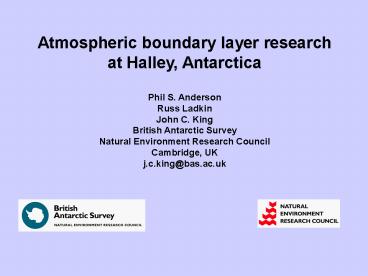Atmospheric boundary layer research - PowerPoint PPT Presentation
1 / 13
Title:
Atmospheric boundary layer research
Description:
John C. King. British Antarctic Survey. Natural Environment ... Science queries to John King or Phil Anderson. Technical queries on instruments to Russ Ladkin ... – PowerPoint PPT presentation
Number of Views:144
Avg rating:3.0/5.0
Title: Atmospheric boundary layer research
1
Atmospheric boundary layer research at Halley,
Antarctica Phil S. Anderson Russ Ladkin John C.
King British Antarctic Survey Natural Environment
Research Council Cambridge, UK j.c.king_at_bas.ac.uk
2
Why study the ABL in Antarctica ?
- Boundary-layer processes exert strong control
over - SH high latitude circulation, driving the
katabatic - circulation.
- Boundary-layer parametrisations currently used
in - GCMs may not be appropriate for Antarctic
conditions - Antarctica offers some near-ideal sites for SBL
studies - - little or no diurnal variation
- - strong stability
- - uniform, flat and unobstructed sites
- Turbulent transport is a key part of air-snow
exchange
3
Halley Research Station
- 75oS, 26oW, 30 m.a.s.l.
- Brunt Ice Shelf - flat, uniform, unobstructed
- Prevailing easterlies have gt 50 km fetch
- 3 months of winter darkness
- Synoptic and upper-air station (WMO 89022)
4
(No Transcript)
5
History of boundary-layer studies at Halley (1)
1986 Stable Antarctic Boundary Layer Expt.
(STABLE) 10-min eddy-correlation fluxes from
sonic anemometers at 5, 15, 30m Profiles of
mean wind and temperature to 30m Sodar 1991
STABLE-II As STABLE, plus Microbarograph
array Blowing snow measurements
6
History of boundary-layer studies at Halley (2)
1995 - 2000 FLUX/Polar Snow 10-min eddy
correlation fluxes at 4m Limited profile to 10
m Snow surface and snowpack temperatures Solar
and terrestrial radiation Sodar Tethersonde
profiling 1995 - ? Katabatic wind studies AWS
network up continental slope inland from
Halley Autonomous doppler sodar deployed 2002
7
(No Transcript)
8
Autonomous Doppler Sodar system
9
Planned measurements at Halley, 2002-2005
- Turbulence
- Metek sonic anemometers at 4, 15, 30m
- Sampling at 40Hz, recorded continuously at 10Hz
- 2 additional Meteks at 10m on remote masts
- Applied Technologies M100 infrared hygrometer
for - fast-response water vapour measurement
10
Planned measurements at Halley, 2002-2005
- Mean profiles
- Vaisala HMP35 (Temperature/humidity) in
aspirated - radiation shields at 1, 2, 4, 8, 15 and 30m
- RM Young propellor/vane Wind Monitor at 1, 2, 4,
8, - 15 and 30m
- Cooled-mirror frost point hygrometer (Michell
- Dewmet) for accurate humidity measurement
- Record 10-minute means
11
Planned measurements at Halley, 2002-2005
- Radiation and snow temperature
- Global, diffuse and reflected shortwave (Kipp
- Zonen solarimeters, aspirated and heated)
- Downwelling and upwelling longwave (Kipp Zonen
- pyrgeometers, aspirated and heated)
- Didcot Instruments net radiometer
- 2 x Heitronics infrared thermometers for snow
- surface temperature
- Snow temperature profile to 10m depth
- Record 10 minute means
12
Planned measurements at Halley, 2002-2005
- Other measurements
- Microbarograph array
- Sodar array
- Kite / helikite tethersonde for measuring
temperature, - humidity and wind profiles to 500m. Usually
used - during limited, intensive campaigns
- Routine daily (1200 UTC) launch of Vaisala
- radiosonde with GPS windfinding. Sounding to
- 100 hPa. Fine structure data retained.
- (contact BAS Meteorological and Ozone
Monitoring - Unit for data)
13
Further information
- Bibliography please take one
- Science queries to John King or Phil Anderson
- Technical queries on instruments to Russ Ladkin































